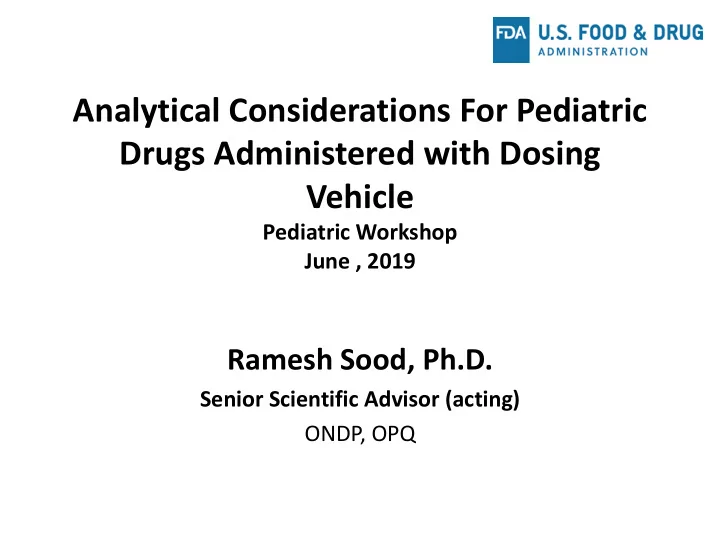

Analytical Considerations For Pediatric Drugs Administered with Dosing Vehicle Pediatric Workshop June , 2019 Ramesh Sood, Ph.D. Senior Scientific Advisor (acting) ONDP, OPQ
Outline • Challenges associated with administration using dosing vehicles • Designing compatibility studies • Case studies • Questions for discussion 2
Special Needs for Pediatric Dosage Forms • Need to further manipulate commercially available product before administration – Unable to swallow intact product (children, adolescents, elderly) – Palatability/taste/texture – Unavailability of appropriate dosage strengths to meet child’s need • May need small amounts of liquid/soft foods as a suitable dosing vehicle 3
Dosage Administration Considerations • Selection of nature and amount of dosing vehicle • Stability of the API in dosing vehicle – Chemical compatibility with the dosing vehicle – Performance of the drug product • Ability to deliver desired dose to the patient (dose flexibility) • Acceptability of the modified preparation • Uniformity of drug in the dosing vehicle • Bioavailability impact (complexation with vehicle components) • Any safety challenge associated with modification 4
Analytical Method Considerations • Analytical Method – Does the drug substance get exposed to vehicle? • If no, changes in potency or performance not expected, need to be demonstrated • If yes, testing for potency and performance needed • Methods need to be validated – Any source of interference from vehicle should be understood and addresses • Drug extraction/Sample handling – Does the drug substance dissolve in vehicle? • Leveraging existing analytical methods 5
In-use Compatibility Studies • Conducted to support the drug product use by the patient/care giver – Product expiration period is assigned by agency to the product packaged in the original container closure – In-use compatibility studies conducted for all products – Cover the environmental and other in-use factors experienced by the product after the primary CC is breached and any manipulations of the product prior to administration – To support administration instructions and storage conditions in the labeling 6
Product Manipulations • Typical manipulations for dosage administration – Dispersing or crushing of tablets – Opening of capsules/mixing with dosing vehicle – Mixing original dosage form/crushed dosage form with dosing vehicle (e.g., food, milk, baby formula etc.) 7
Designing Compatibility Studies • Test for critical quality attributes that are susceptible to change during manipulation and storage – Appearance, assay, impurities, product integrity, dissolution/drug release testing • Qualify the time and the storage conditions during which the product must be used • Experience on usability/acceptability of modified product during clinical studies • These studies should be the basis for use instructions in labeling (e.g., may need to include information if some common foods are not compatible) 8
Case Study • Multiple strengths of tablets (low, medium and high) • Initially proposed to administer crushed tablets mixed with apple puree, water and milk as dosing vehicle – Dosing with water and milk to be given through baby bottles or medical syringe • Testing of crushed tablets with apple puree showed acceptable dose recovery, consistency and stability • Testing of dosing with milk and water gave relatively low recovery and variable replicate results – Baby bottle: water 20.3-42.4%; Milk: 51.1-66% – 5 ml Syringe at RT: water 64-83%; Milk 83-93% 9
Case Study • Low recovery due to incomplete recovery of drug particles from the dosing vessels (drug particles are suspended in milk and water) • Additional interactions with the applicant during review process to develop alternative dosing procedure • New method developed involved obtaining suspension of drug through disintegration of tablet in water – Gave acceptable recovery results – Approved to be used within 2 hours as opposed to requested 48 hours because lack of assay information and microbiology data for 48 hours – Led to detailed preparation procedure in the labeling including, amount of water to be used in the syringe, time to get complete disintegration, rinsing step 10
Resources • (Draft): Use of liquids and /or soft foods as vehicle for drug administration: General considerations for selection and in vitro methods for product quality assessmentshttps://www.fda.gov/media/114872/download • Guidance for Industry: Stability testing of new drug substances and products. https://www.fda.gov/media/71707/download 11
Questions to Consider • How do you select dosing vehicles to be studied when dosing vehicle is needed for administration? • What analytical tests are conducted during dosing vehicle compatibility studies? – Physical and chemical stability, extractability, taste/palatability, drug release/bioavailability, dosing accuracy, dose uniformity • What analytical challenges are faced in conducting these studies? – Sample preparations related – Analytical procedure/validation related • Are there any region specific compatibility studies conducted? • Considerations for including dosing vehicle in the packaging • How do you select a particular dosage form/dosage strengths? 12
Thank you! Questions? 13 www.fda.gov
Recommend
More recommend